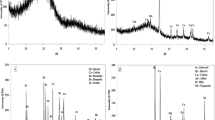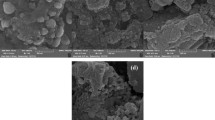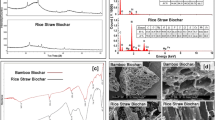Abstract
The interaction between biochar and heavy metals in the presence of low molecular weight organic acids is largely unknown, but it is important to understand biochar’s influence on heavy metals immobilizing in the rhizosphere. The impacts of different amounts of biochar (5%) and citric acid, coupled with combinations of biochar and citric acid on the redistribution of cadmium, lead, and zinc among their different geochemical forms, including their bioavailability in metal contaminated soil, were investigated in an incubation experiment. Adding biochar, low concentration of citric acid (2 mmol kg−1 soil), and biochar with a low level of citric acid markedly reduced the acid-soluble and available (CaCl2-extractable) cadmium, lead, and zinc compared to control in which biochar plus low concentration of citric acid proved to be the most effective treatment. These trends were reversed in the case of high concentrations of citric acid (> 5–20 mmol kg−1 soil) and the combined biochar plus high levels of citric acid treatments. With incubation time, biochar in combination with a low concentration of citric acid transformed the largest amounts of acid-soluble and reducible cadmium, lead, and zinc into oxidizable and residual fractions. These results suggested that a low level of citric acid enhanced metals’ immobilization, while higher concentration of citric acid increased their mobilization. The study concluded that biochar with this low level of citric acid did in fact emerge as the best treatment, and can serve as an amendment for metals’ immobilization/redistribution in contaminated soils.
Graphic abstract




Similar content being viewed by others
Code availability
Not applicable.
References
Ahmad M, Lee SS, Lee SE, Al-Wabel MI, Tsang DCW, Ok YS (2017) Biochar-induced changes in soil properties affected immobilization/mobilization of metals/metalloids in contaminated soils. J Soils Sediments 7:717–730. https://doi.org/10.1007/s11368-015-1339-4
Ahmad M, Hashimoto Y, Moon DH, Sang SL, Ok YS (2012) Immobilization of lead in a Korean military shooting range soil using eggshell waste: an integrated mechanistic approach. J Hazard Mater 209–210:392–401. https://doi.org/10.1016/j.jhazmat.2012.01.047
Alozie N, Heaney N, Lin C (2018) Biochar immobilizes soil-borne arsenic but not cationic metals in the presence of low-molecular-weight organic acids. Sci Total Environ 630:1188–1194. https://doi.org/10.1016/j.scitotenv.2018.02.319
Boostani HR, Hardie AG, Najafi-Ghiri M, Khalili D (2018) Investigation of cadmium immobilization in a contaminated calcareous soil as influenced by biochars and natural zeolite application. Int J Environ Sci Technol 15:2433–2446. https://doi.org/10.1007/s13762-017-1544-3
Cao X, Ma L, Liang Y, Gao B, Harris W (2011) Simultaneous immobilization of lead and atrazine in contaminated soils using dairy-manure biochar. Environ Sci Technol 45(11):4884–4889. https://doi.org/10.1021/es103752u
Chen Z, Zhang J, Liu M, Wu Y, Yuan Z (2018) Immobilization of metals in contaminated soil from E-waste recycling site by dairy-manure-derived biochar. Environ Technol 39(21):2801–2809. https://doi.org/10.1080/09593330.2017.1365947
Collins RN, Merrington G, McLaughlin MJ, Morel JL (2003) Organic ligand and pH effects on isotopically exchangeable cadmium in polluted soils. Soil Sci Soc Am J 67(1):112–121. https://doi.org/10.2136/sssaj2003.1120
Ding YZ, Song ZG, Feng RW, Guo JK (2014) Interaction of organic acids and pH on multi-heavy metal extraction from alkaline and acid mine soils. Int J Environ Sci Technol 11:33–42. https://doi.org/10.1007/s13762-013-0433-7
Ding YZ, Tang SR, Li ZA, Murray M (2008) Effects of low molecule weight organic acids on Cd solubility in paddy and red soils in South China. Res J Chem Environ 12(1):7–16
El-Naggar A, Lee SS, Rinklebe J, Farooq M, Song H, Sarmah AK, Zimmerman AR, Ahmad M, Shaheen SM, Ok YS (2019) Biochar application to low fertility soils: a review of current status, and future prospects. Geoderma 337:536–554. https://doi.org/10.1016/j.geoderma.2018.09.034
Gao Y, Yang Y, Ling W, Kong H, Zhu X (2011) Gradient distribution of root exudates and polycyclic aromatic hydrocarbons in rhizosphere soil. Soil Sci Soc Am J 75:1694–1703. https://doi.org/10.2136/sssaj2010.0244
Gao Y, He J, Ling W, Hu HQ, Liu F (2003) Effects of organic acids on copper and cadmium desorption from contaminated soils. Environ Int 29(5):613–618. https://doi.org/10.1016/S0160-4120(03)00048-5
Ho S-H, Chen Y, Yang Z, Nagarajan D, Chang J-S, Ren N (2017) High-efficiency removal of lead from wastewater by biochar derived from anaerobic digestion sludge. Bioresour Technol 246:142–149. https://doi.org/10.1016/j.biortech.2017.08.025
Houba VJG, Temminghoff EJM, Gaikhorst GA, van Vark W (2000) Soil analysis procedures using 0.01M calcium chloride as extraction reagent. Commun Soil Sci Plant Anal 31(9–10):1299–1396. https://doi.org/10.1080/00103620009370514
Houba VJG, Lexmond TM, Novozamsky I, van der Lee JJ (1996) State of the art and future developments in soil analysis for bio-availability assessment. Sci Total Environ 178(1–3):21–28. https://doi.org/10.1016/0048-9697(95)04793-X
Houben D, Evrard L, Sonnet P (2013) Beneficial effects of biochar application to contaminated soils on the bioavailability of Cd, Pb and Zn and the biomass production of rapeseed (Brassica napus L.). Biomass Bioenergy 57:196–204. https://doi.org/10.1016/j.biombioe.2013.07.019
Hu HQ, Liu HL, He JZ, Huang QY (2007) Effect of selected organic acids on cadmium sorption by variable- and permanent-charge soils. Pedosphere 17(1):117–123. https://doi.org/10.1016/S1002-0160(07)60016-2
Huang G, Gao R, You J, Zhu J, Fu Q, Hu HQ (2019) Oxalic acid activated phosphate rock and bone meal to immobilize Cu and Pb in mine soils. Ecotox Environ Saf 174:401–407. https://doi.org/10.1016/j.ecoenv.2019.02.076
Huang L, Hu HQ, Li X, Li LY (2010) Influences of low molar mass organic acids on the adsorption of Cd2+ and Pb2+ by goethite and montmorillonite. Appl Clay Sci 49(3):281–287. https://doi.org/10.1016/j.clay.2010.06.005
Igalavithana AD, Mandal S, Niazi NK, Vithanage M, Parikh SJ, Mukome FND, Rizwan M, Oleszczuk P, Al-Wabel M, Bolan N, Tsang DCW, Kim KH, Ok YS (2018a) Advances and future directions of biochar characterization methods and applications. Crit Rev Environ Sci Technol 47(23):2275–2330. https://doi.org/10.1080/10643389.2017.1421844
Igalavithana AD, Yang X, Zahra HR, Tack FMG, Tsang DCW, Kwon EE, Ok YS (2018b) Metal(loid) immobilization in soils with biochars pyrolyzed in N2 and CO2 environments. Sci Total Environ 630:1103–1114. https://doi.org/10.1016/j.scitotenv.2018.02.185
Jiang H, Li T, Han X, Yang X, He Z (2012a) Effects of pH and low molecular weight organic acids on competitive adsorption and desorption of cadmium and lead in paddy soils. Environ Monitor Assess 184:6325–6335. https://doi.org/10.1007/s10661-011-2422-y
Jiang J, Xu RK, Jiang TY, Li Z (2012b) Immobilization of Cu (II), Pb (II) and Cd (II) by the addition of rice straw derived biochar to a simulated polluted Ultisol. J Hazard Mater 229–230:145–150. https://doi.org/10.1016/j.jhazmat.2012.05.086
Kim H-S, Kim K-R, Kim H-J, Yoon J-H, Yang JE, Ok YS, Owens G, Kim K-H (2015) Effect of biochar on heavy metal immobilization and uptake by lettuce (Lactuca sativa L.) in agricultural soil. Environ Earth Sci 74:1249–1259. https://doi.org/10.1007/s12665-015-4116-1
Kissel DE, Sonon L, Vendrell PF, Isaac RA (2009) Salt concentration and measurement of soil pH. Commun Soil Sci Plant Anal 40(1–6):179–187. https://doi.org/10.1080/00103620802625377
Krishnamurti GSR, Cieslinski G, Huang PM, Van Rees KCJ (1997) Kinetics of cadmium release from soils as influenced by organic acids: Implication in cadmium availability. J Environ Qual 26(1):271–277. https://doi.org/10.2134/jeq1997.00472425002600010038x
Li S, Wang M, Zhao Z, Ma C, Chen S (2018) Adsorption and desorption of Cd by soil amendment: mechanisms and environmental implications in field-soil remediation. Sustain 10(7):2337. https://doi.org/10.3390/su10072337
Lu HP, Li ZA, Gascó G, Méndez A, Shen Y, Paz-Ferreiro J (2018) Use of magnetic biochars for the immobilization of heavy metals in a multi-contaminated soil. Sci Total Environ 622–623:892–899. https://doi.org/10.1016/j.scitotenv.2017.12.056
Lu K, Yang X, Gielen G, Bolan N, Ok YS, Niazi NK, Xu S, Yuan G, Chen X, Zhang X, Liu D, Song Z, Liu X, Wang H (2017) Effect of bamboo and rice straw biochars on the mobility and redistribution of heavy metals (Cd, Cu, Pb and Zn) in contaminated soil. J Environ Manag 186(2):285–292. https://doi.org/10.1016/j.jenvman.2016.05.068
Lu H, Li Z, Fu S, Méndez A, Gascó G, Paz-Ferreiro J (2015) Effect of biochar in cadmium availability and soil biological activity in an anthrosol following acid rain deposition and aging. Water Air Soil Pollut 226:164. https://doi.org/10.1007/s11270-015-2401-y
Lu K, Yang X, Shen J, Robinson B, Huang H, Liu D, Bolan N, Pei J, Wang H (2014) Effect of bamboo and rice straw biochars on the bioavailability of Cd, Cu, Pb and Zn to Sedum plumbizincicola. Agric Ecosyst Environ 191:124–132. https://doi.org/10.1016/j.agee.2014.04.010
Ma H, Li X, Wei M, Zeng G, Hou S, Li D, Xu H (2020) Elucidation of the mechanisms into effects of organic acids on soil fertility, cadmium speciation and ecotoxicity in contaminated soil. Chemosphere 239:124706. https://doi.org/10.1016/j.chemosphere.2019.124706
Ministry of Ecology and Environment of People's Republic of China (PRC), State Administration for Market Regulation of PRC. Soil environmental quality (GB 15618-2018). Risk control standard for soil contamination of agricultural land of PRC (in Chinese)
Mondal SC, Sarma B, Farooq M, Nath DJ, Gogoi N (2020) Cadmium bioavailability in acidic soils under bean cultivation: role of soil additives. J Environ Sci Technol 17:153–160. https://doi.org/10.1007/s13762-019-02263-0
Nannoni F, Protano G, Riccobono F (2011) Fractionation and geochemical mobility of heavy elements in soils of a mining area in northern Kosovo. Geoderma 161(1–2):63–73. https://doi.org/10.1016/j.geoderma.2010.12.008
Netherway P, Reichman SM, Laidlaw M, Scheckel K, Pingitore N, Gasco G, Mendez A, Surapaneni A, Paz-Ferreira J (2019) Phosphorus-rich biochars can transform lead in an urban contaminated soil. J Environ Qual 48(4):1091–1099. https://doi.org/10.2134/jeq2018.09.0324
Nigam N, Yadav V, Mishra D, Karak T, Khare P (2019) Biochar amendment alters the relation between the Pb distribution and biological activities in soil. Int J Environ Sci Technol 16:8595–8606. https://doi.org/10.1007/s13762-019-02257-y
Oziegbe O, Aladesanmi OT, Awotoye OO (2019) Effect of biochar on the nutrient contents and metal recovery efficiency in sorghum planted on landfill soils. Int J Environ Sci Technol 16:2259–2270. https://doi.org/10.1007/s13762-018-1843-3
Qin F, Shan XQ, Wei B (2004) Effects of low-molecular-weight organic acids and residence time on desorption of Cu, Cd, and Pb from soils. Chemosphere 57(4):253–263. https://doi.org/10.1016/j.chemosphere.2004.06.010
Rauret G, Lopez-Sanchez JF, Sahuquillo A, Rubio R, Davidson C, Ure A, Quevauviller Ph (1999) Improvement of the BCR three step sequential extraction procedure prior to the certification of new sediment and soil reference materials. J Environ Monit 1(1):57–61. https://doi.org/10.1039/A807854H
Rechberger MV, Kloss S, Wang SL, Lehmann J, Rennhofer H, Ottner F, Wriessnig K, Daudin G, Lichtenegger H, Soja G, Zehetner F (2019) Enhanced Cu and Cd sorption after soil aging of woodchip-derived biochar: what were the driving factors? Chemosphere 216:463–471. https://doi.org/10.1016/j.chemosphere.2018.10.094
Rinklebe J, Shaheen SM (2017) Geochemical distribution of Co, Cu, Ni, and Zn in soil profiles of Fluvisols, Luvisols, Gleysols, and Calcisols originating from Germany and Egypt. Geoderma 307:122–138. https://doi.org/10.1016/j.geoderma.2017.08.005
Rukshana F, Butterly CR, Baldock JA, Tang C (2011) Model organic compounds differ in their effects on pH changes of two soils differing in initial pH. Biol Fertil Soils 47:51–62. https://doi.org/10.1007/s00374-010-0498-0
Salam A, Shaheen SM, Bashir S, Khan I, Wang J, Rinklebe J, Rehman FU, Hu HQ (2019) Rice straw- and rapeseed residue-derived biochars affect the geochemical fractions and phytoavailability of Cu and Pb to maize in a contaminated soil under different moisture content. J Environ Manag 237:5–14. https://doi.org/10.1016/j.jenvman.2019.02.047
Ugochukwu N, Hongqing H (2013) Organic acids influence on lead adsorption onto variable charge soils in China. Int J Dev Sustain 2(3):2110–2123
Vamvuka D, Dermitzakis S, Pentari D, Sfakiotakis S (2018) Valorization of meat and bone meal through pyrolysis for soil amendment or lead adsorption from wastewaters. Food Bioprod Process 109:148–157. https://doi.org/10.1016/j.fbp.2018.04.002
Wagner A, Kaupenjohann M, Hu Y, Kruse J, Leinweber P (2015) Biochar-induced formation of Zn–P-phases in former sewage field soils studied by PK-edge XANES spectroscopy. J Plant Nutr Soil Sci 178(4):582–585. https://doi.org/10.1002/jpln.201400601
Yang X, Liu J, McGrouther K, Huang H, Lu K, Guo X, He L, Lin X, Che L, Ye Z, Wang H (2106) Effect of biochar on the extractability of heavy metals (Cd, Cu, Pb, and Zn) and enzyme activity in soil. Environ Sci Pollut Res 23:974–984. https://doi.org/10.1007/s11356-015-4233-0
Zhuang P, McBribe MB, Xia H, Li N, Li Z (2009) Health risk from heavy metals via consumption of food crops in the vicinity of Dabaoshan Mine, South China. Sci Total Environ 407(5):1551–1561. https://doi.org/10.1016/j.scitotenv.2008.10.061
Acknowledgements
The research is financially supported by the National Science and Technology Support Plan of China (2015BAD05B02).
Author information
Authors and Affiliations
Contributions
Md. Shoffikul Islam contributed to conceptualization, methodology, software, investigation, writing—original draft preparation; RuiliGao contributed to formal analysis and investigation; Jieyu Gao contributed to formal analysis and investigation; Ziteng Song contributed to formal analysis and investigation; Umeed Ali contributed to formal analysis and investigation; Hongqing Hu contributed to review and editing, funding acquisition, resources, supervision.
Corresponding author
Ethics declarations
Conflicts of interest
The authors declare that they have no conflict of interest.
Availability of data and material
Not applicable.
Consent to participate
Not applicable.
Consent for publication
Not applicable.
Ethics approval
Not applicable.
Additional information
Editorial responsibility: Samareh Mirkia.
Supplementary Information
Below is the link to the electronic supplementary material.
Rights and permissions
About this article
Cite this article
Islam, M.S., Gao, R., Gao, J. et al. Cadmium, lead, and zinc immobilization in soil using rice husk biochar in the presence of citric acid. Int. J. Environ. Sci. Technol. 19, 567–580 (2022). https://doi.org/10.1007/s13762-021-03185-6
Received:
Revised:
Accepted:
Published:
Issue Date:
DOI: https://doi.org/10.1007/s13762-021-03185-6




